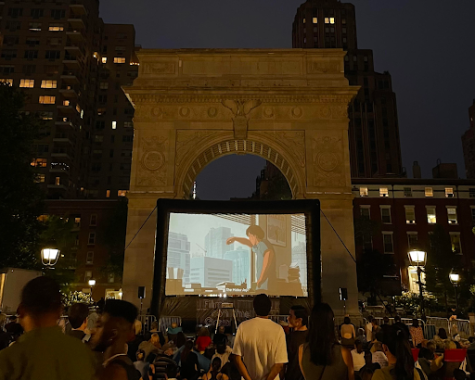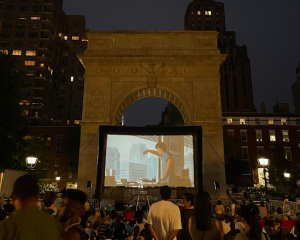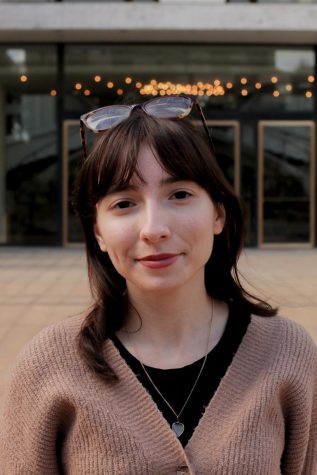Theater Arts in the Archives
The Theatre on Film and Tape Archive showcases 50 years of center stage, behind the scenes and all-around creative preservation in a landmark theater exhibition
The NYPL’s “Focus Center Stage: 50 Years of the Theatre on Film and Tape Archive” exhibit displays playbills of some of the Broadway shows TOFT has recorded over the years.
September 14, 2022
CORRECTION: A previous version of this article stated that TOFT received its Tony award in 2002. As of Sep. 25, 2022, the article has been updated to show the award was received in 2001.
Located at 40 Lincoln Center Plaza, a short walk from Fordham’s Lincoln Center campus, the New York Public Library for the Performing Arts is celebrating 50 years of its landmark video-recorded theatre archive in an exhibition titled “Focus Center Stage: 50 Years of the Theatre on Film and Tape Archive.”
Each aspect of the Theatre on Film and Tape Archive (TOFT) is commemorated with video monitors streaming snippets of musicals, plays and interviews that can be heard through the adjustable headsets attached.
“Just by walking through the exhibition, (students) can get a sense of the breadth and depth of the collection, of all the recordings. It’s literally five decades of history — there’s something for everyone,” TOFT Assistant Director Wendy Norris said.
The exhibition begins with a mural of poster-sized playbills representing the work recorded by TOFT. The exhibition path is lined with snippets of the archives of over 8,000 video recordings, about 4,500 of those being live performances. The showcase even includes musicals and plays in the avant-garde, such as the first recorded production for the archive: an Off-Broadway rock musical with an all Asian cast titled “Golden Bat.”
Concluding the first floor of the exhibition is an interview reel of TOFT Founder Betty Corwin, after her retirement in 2001. In the video, Corwin listed off values important to her, which she took into account when founding the archive in 1970.
Corwin mentioned representation of women, people of color, LGBTQ+ and those with disabilities as important to the message and tradition of TOFT. She believed that theater recordings “reflect the times, reflect the three decades of what went on in the world.”
To Corwin, theater is not only part of culture but how people measure history.
“Preserving theater history was really one of the main aims of establishing the collection and also saving these recordings for future generations to study, and learn from, and be inspired by.” Wendy Norris, New York Public Library’s Theatre on Film and Tape Archive Assistant Director
TOFT consistently takes into account the diversity of each story, along with artistic merit, when deciding what 40-50 productions to record each season. Norris admitted narrowing the list to conform with financial and temporal resources is difficult.
TOFT also has collections of notable theater professional performances, such as the first act workshop of Sondheim’s “Sunday in the Park with George.”
The remainder of TOFT’s recorded collection consists of interviews, theater awards programs and film adaptations — including the film adaptation of “Fences” starring Denzel Washington, Fordham College at Lincoln Center ’77.
Preservation is a harbinger of progress to those at TOFT. Norris said that prior to the pandemic, researchers traveled from around 48 states and 32 countries to access the materials, as “preserving theater history was really one of the main aims of establishing the collection and also saving these recordings for future generations to study, and learn from, and be inspired by.”
Norris noted that their largest audience is probably theater professionals, but student groups such as English classes and art history courses have also used their viewing rooms.
Fordham Communications department professor Jennifer Clark said that she has used the archive for her own research and for a course on costume design.
Clark said that there is much notable scholarship that has come out of the TOFT, such as “Divine Decadence: Fascism, Female Spectacle, and the Makings of Sally Bowles” by Linda Mizejewski, emphasizing the expanse of research that is accessible mere strides away.
As Norris noted, “theater kind of reflects life.” Almost anything at TOFT could intersect with one’s studies.
“I think theater, really — it needs support, it needs audiences. That’s the beauty of live performance, is that it’s a conversation between performers, the creators and the audience — it’s a give and take.” Norris
On the left side of the first floor exhibition is a glass case with Corwin’s photo, with chocolate bars stacked underneath — a traditional gift to stagehands that Corwin began.
Upstairs, pictures set in film cell frames display the behind-the-scenes work of stagehands, camerapeople, costume designers, playwrights and directors.
“We wanted to bring out the fact that the archive has been successful because of the great cooperation of all the theater artists who all have to give their permission for a production to be recorded,” Norris said.
TOFT’s 2001 Tony award, also on display in the exhibition, spotlights the amicable appreciation between theater creators and the theater preservers at TOFT.
Norris also stressed the importance of audiences, virtual or otherwise.
To view Broadway and Off-Broadway productions alike, library card holders can take the elevator to the third floor, where the Lucille Lortel screening room houses 24 computer monitors and video screens encompassing the room in a thrum of white noise.
“I think theater, really — it needs support, it needs audiences. That’s the beauty of live performance, is that it’s a conversation between performers, the creators and the audience — it’s a give and take,” she said.
The most recent recordings for the archive were the Broadway production of Billy Crystal’s “Mr. Saturday Night” and the off-Broadway production “On that Day in Amsterdam.”
To view Broadway and Off-Broadway productions alike, library card holders can take the elevator to the third floor, where the Lucille Lortel screening room houses 24 computer monitors and video screens encompassing the room in a thrum of white noise.
According to Norris, the monitors are used for playback controls, while the video signals are sent from the archival recordings and playback decks in the basement to the booked video screens. There are also bookable viewing rooms suitable for classes or large presentations, equipped with film and DVD projectors.
The exhibition begins at the Plaza entrance to the New York Public Library for the Performing Arts and spans the first two floors of the library, accessible by stairs or elevator.
To get involved with theater preservation, you can support the archive for free with a New York Public Library card. Contacts and additional information about the exhibition, archive appointments and New York Public Library research can be found here.




















